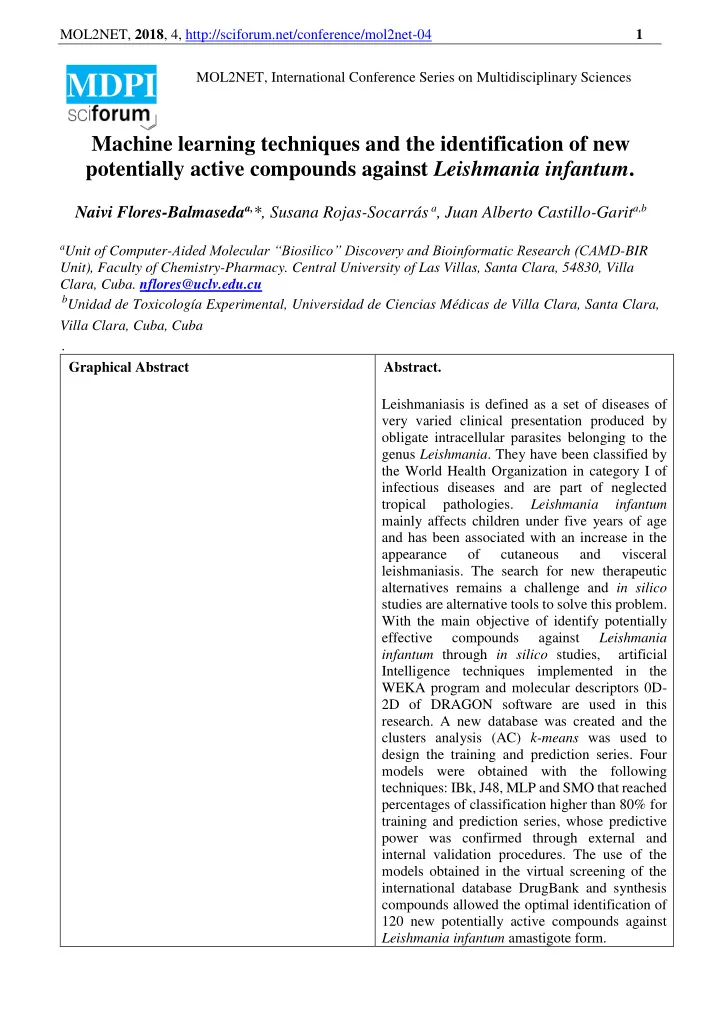

MOL2NET, 2018 , 4, http://sciforum.net/conference/mol2net-04 1 MOL2NET, International Conference Series on Multidisciplinary Sciences MDPI Machine learning techniques and the identification of new potentially active compounds against Leishmania infantum . Naivi Flores-Balmaseda a, *, Susana Rojas-Socarrás a , Juan Alberto Castillo-Garit a,b a Unit of Computer- Aided Molecular “Biosilico” Discovery and Bioinformatic Research (CAMD -BIR Unit), Faculty of Chemistry-Pharmacy. Central University of Las Villas, Santa Clara, 54830, Villa Clara, Cuba. nflores@uclv.edu.cu b Unidad de Toxicología Experimental, Universidad de Ciencias Médicas de Villa Clara, Santa Clara, Villa Clara, Cuba, Cuba . Graphical Abstract Abstract. Leishmaniasis is defined as a set of diseases of very varied clinical presentation produced by obligate intracellular parasites belonging to the genus Leishmania . They have been classified by the World Health Organization in category I of infectious diseases and are part of neglected tropical pathologies. Leishmania infantum mainly affects children under five years of age and has been associated with an increase in the appearance of cutaneous and visceral leishmaniasis. The search for new therapeutic alternatives remains a challenge and in silico studies are alternative tools to solve this problem. With the main objective of identify potentially effective compounds against Leishmania infantum through in silico studies, artificial Intelligence techniques implemented in the WEKA program and molecular descriptors 0D- 2D of DRAGON software are used in this research. A new database was created and the clusters analysis (AC) k-means was used to design the training and prediction series. Four models were obtained with the following techniques: IBk, J48, MLP and SMO that reached percentages of classification higher than 80% for training and prediction series, whose predictive power was confirmed through external and internal validation procedures. The use of the models obtained in the virtual screening of the international database DrugBank and synthesis compounds allowed the optimal identification of 120 new potentially active compounds against Leishmania infantum amastigote form.
MOL2NET, 2018 , 4, http://sciforum.net/conference/mol2net-04 2 Keywords Leishmaniasis; machine learning techniques; protozoo; WEKA software; Leishmania infantum ; amastigote. Machine (SMO for Sequential Minimal Optimization ). Introduction For training and prediction series, they reached Leishmaniasis incidence has increased from the percentages of classification higher than 80% whose years 80, and it has won a relevant position among the predictive power was confirmed through external and causes of death for infectious illnesses worldwide[1]. internal validation procedures (sensitivity, specificity, They have been classified by the World Health Matthews’s correlation coefficient, false positive Organization in category I of infectious diseases and relationship and accuracy for the training and are part of neglected tropical pathologies. Leishmania prediction series were determined for each model). infantum mainly affects children under five years of Classification percentages for training and prediction age and has been associated with an increase in the series in the final models obtained in this work results appearance of cutaneous and visceral higher in IBk model followed by J48, figure 2. The leishmaniasis[2]. The search for new therapeutic external validation of 44 previously bioassayed alternatives remains a challenge and in silico studies compounds (PubChem) yielded positive results for the are alternative tools to solve this problem[3]. four models used for amastigotes demonstrating its high degree of predictability, robustness and reproducibility. Materials and Methods In this work, 437 PubChem bioassays tested Figure 2. Classification percentages (Accuracy) for compounds against the amastigote form of L. infantum TS and PS in final models. parasite were selected to construct a new database with a high degree of structural variability; they have been tested experimentally through trials with very similar procedures. To classify them into active or inactive against this stage of parasite life the IC 50 was used. Different families of 0-2D molecular descriptors were calculated using DRAGON software[4]. Conglomerate analysis (AC) implemented in the STATISTICA 8.0 processing package was carried out, as a way of evaluating the existing structural diversity and distribution within the groups of active and inactive observations respectively, figure 1. The active and inactive compounds were in turn divided into different subsets by means of two conglomerate analyzes of the k-MCA type[5]. From each conglomerate, the compounds for the conformation of the training, prediction and external validation series were A total of 5 128 compounds of different origin randomly selected; the used procedure is shown in (DrugBank international database, and new synthesis Figure 2. WEKA’s selection procedures were used to compounds) that had not been tested experimentally obtain a subset of variables for models against L. infantum were virtually screened, this development[6]. allowed the identification of new potentially active agents against the amastigote form of this parasite, Figure 1. Conglomerate analysis and series resulting in the identification of a wide structural variety conformation. compounds for each of the four models. Virtual screening allowed the optimal identification of 120 new potentially active compounds against Leishmania infantum amastigote form, which will be evaluated experimentally in subsequent studies to corroborate their activity. References 1. Organización Panamericana de la Salud: Leishmaniasis: Informe Epidemiológico en las Américas: Washington: Organización Panamericana de la Salud, 2016 Available in http://www.paho.org/ accessed on 12 sept 2016 Results and Discussion 2. Ramos, JM; Segovia, M; Estado actual del Four models were obtained with the following tratamiento farmacológico de la leishmaniasis. [cited techniques: k-Nearest Neighbors (IBK), Classification 2016]; Available from: Trees (J48), Artificial Neural Network (MLP for its acronym MultiLayer Perceptron ) and Support Vector
MOL2NET, 2018 , 4, http://sciforum.net/conference/mol2net-04 3 http://www.seq.es/seq/html/revista_seq/0197/rev1.ht ml. 3. Timothy G. Geary; Judy A. Sakanari, and Conor R. Caffrey Anthelmintic Drug Discovery: Into the Future. Journal of Parasitology 2015, 101, No. 2, 125-133. 4. Todeschini R, Consonni V, Mauri A, Pavan M. DRAGON-Software for the calculation of molecular descriptors, version 5.5 for Windows; Talete SRL: Milan, Italy. 2007 5. Xu, J; Hagler A. Chemoinformatics and drug discovery. Molecules. 2002;7(8):566-600.Hall M, Create PDF files without this message by purchasing novaPDF printer (http://www.novapdf.com) MOL2NET, 2018 , 4, http://sciforum.net/conference/mol2net-04 4 6. Frank E, Holmes G, Pfahringer B, Reutemann P, Witten IH. The WEKA data mining software: an update. ACM SIGKDD explorations newsletter. 2009 Nov 16;11(1):10 -8.
Recommend
More recommend